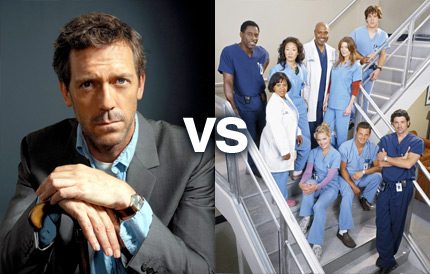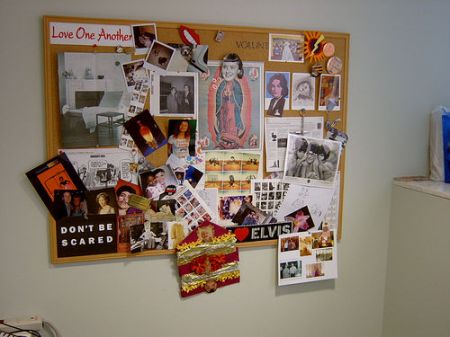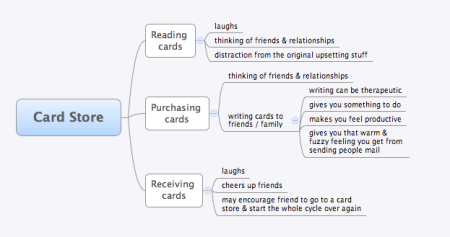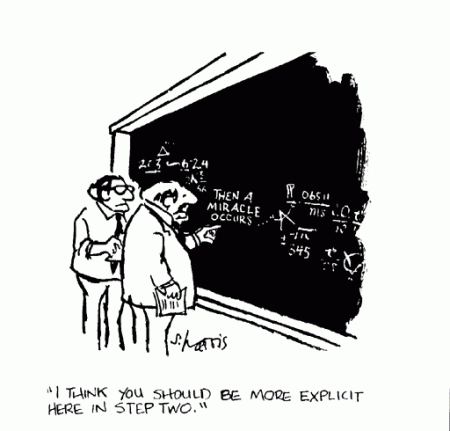Posts Tagged ‘EDNOS’
November 11, 2009
I’ve been in all different levels of treatment with numerous professionals and various treatment centers, and overall I’d have to say that both group and individual therapy are important (and beneficial) in recovery. With group, there are several people who you can bounce ideas off of, get advice from, relate to, and rely on for support. I feel like most of the real therapy work happens in individual, though, where you can focus on your specific issues, goals, etc. I really do think it helps to have both individual and group components to your treatment plan, though.
This said… something that has always thrown me off is having my individual therapist as my group therapist. This has happened to me a couple of times, in residential, IOP, outpatient, etc. It changes the dynamic for me for a couple of reasons:
- Every time I said something to the group I though, “has she heard this already? did I tell her this before?”
- I read (too much) into the things that she said
- If I were having a bad day, she usually noticed
- I wondered if there would be repercussions to the things I said (for example, I didn’t want to mention something in passing and have to spend the next two individual sessions processing it).
- I worried that I’d treat group like an individual session and spend too much of the total time focusing on my own issues
These aren’t all bad things. It’s good that my therapist would recognize that I was having a crappy day, since I likely wouldn’t have brought it up and the therapists who didn’t know me as well probably didn’t know anything was not right. She also probably pushed me a little harder, since we did have a relationship and she could do that comfortably. So, for the most part, it was good for me to have some groups with my individual therapists.
With all of this said, where things start to get a little messier is when other people in the group also share the same individual therapist. I’ve been in some programs where everyone had the same primary therapist and others where there were a handful of individual therapists that also ran groups. Both situations add that extra variable to the equation – sharing a therapist with another person in your group.
The therapeutic relationship is so unique that sometimes I think it can be challenging to “share” your therapist with someone else that you know. I’m not concerned about the confidentiality as much as the dynamics of the relationship. As the patient, you only have one therapist. When you have a good relationship, it feels special. You feel like you have this connection that maybe other patients don’t have. It makes sense – every week you are confiding in this person, trusting him/her to guide you and to give you some insight. This relationship and person mean something to you. He/she is a part of your life.
Being in a group with your therapist and another one of her patients is a reminder that you’re not the only patient. You know this logically, but the reminder can be kinda tough. Sometimes it’s rough to see her concerned and focusing on someone else. It can feel invalidating. It can feel like a competition between you and the other patient. It can be hurtful if you feel like you’re being ignored or that your interaction with the therapist is different. It really adds a dozen additional variables into the therapeutic relationship equation.
There are a lot of things that make eating disorder groups tough. Girls get competitive over eating, weight, exercise, etc – even if you don’t allow talk about numbers. You have to be careful who you put in a group together, and even having one or two pretty anti-recovery people can change the whole atmosphere. Sharing a therapist with several of the girls almost adds another thing to compete over. Even if you refuse to participate in the competition to get the most attention or require the most concern (really, these competitions exist!), it can be hurtful to to feel neglected or uncared about. I don’t think this is a topic that is often addressed in groups… but I think that sharing a therapist with other girls, and all being in the same group together led by your primary therapist, can be a little tricky…
Tags:Anorexia, anxiety, binge eating, bulimia, depression, eating disorder, eating disorder treatment, ED IOP, EDNOS, group therapy, individual therapy, intensive outpatient, mental health, mental illness, patient, recovery, residential treatment, therapist
Posted in eating disorder, therapist, therapy, treatment | 2 Comments »
October 27, 2009
This is the sixth post in the Grey Thinking series, Five of the most underrated coping skills.

This isn’t going to come as any surprise to those of you who have followed Grey Thinking for any length of time…. but watching DVDs of TV series is one of my favorite “coping skills.” I may be stretching the idea of a “coping skill” a little bit here, but anything to justify my House marathons…
I like to watch four hours of old Grey’s Anatomy episodes (especially during evenings that I’m depressed) because I can check out. I can focus on Meredith’s dark and twisty issues and secretly hope that Meredith and Derek get back together (clearly I’m in the middle of season three right now). And it’s not that House’s misery or Meredith’s really screwed up love life makes me feel better about my own or anything. I just like relationships. And sarcasm.
Checking out like this is probably not THE healthiest coping mechanism – but it’s much better than the eating disorder. Sometimes I am overwhelmed and I need to check out. It’s hard for me to turn off my brain, in a sense. My mind can wander while I read a book, exercise, walk the dog, clean, etc. For some reason though, my mind doesn’t wander when I’m watching House. Things seem so still and the chaos of my life is put on hold.
I say “DVDs” rather than House / Grey’s Anatomy because I have friends who use movies to cope. Personally, I get really impatient with movies and spend a lot of time thinking “is it over yet?” They’re more frustrating to me than soothing… but to each her/his own.
Tags:Anorexia, binge eating disorder, bulimia, coping mechanism, coping skill, dark and twisty, derek, dvd, eating disorder, EDNOS, grey's anatomy, House, meredith, tv marathon, tv series
Posted in coping skill | 2 Comments »
October 23, 2009
This is the fourth post in the Grey Thinking series, Five of the most underrated coping skills.
If you don’t know what a “kudos chart is” – it’s a sticker chart. You know those charts that your mom made when you were five that had actions like “make bed” and “brush teeth” on it? Yep, those. I heard someone refer to them as “kudos charts” on twitter several months back, and since my current chart is not actually using stickers, I’m going to go with that terminology.
My explanation is simple: a kudos chart worked for me when I was five, and twenty years later it is still a helpful tool.
What kind of things do I have on my kudos chart?
- Follow meal plan
- Take calcium supplement
- Get 7+ hours of sleep
- Go through the mail
- Blog
That’s not all, but you get the picture – it’s a mixture of eating disorder goals and regular life tasks. I never have more than 7 goals, for three main reasons:
- then I’m not really focusing on the important tasks
- it gets cumbersome to remember and record too many things
- only seven fit on my chart
Not only do I get satisfaction of checking off items each day, but at the end of the day / week I add up all my “kudos” for my “kudos score.” It’s a quick and satisfying way to motivate myself… and I think that other people could definitely benefit from such a tool.
Tags:Anorexia, binge eating disorder, bulimia, compulsive overeating, coping mechanism, coping skill, coping tool, eating disorder, eating disorder goals, EDNOS, goal chart, goals, kudos chart, sticker chart
Posted in coping skill | 4 Comments »
October 21, 2009
This is the third post in the Grey Thinking series, Five of the most underrated coping skills.
Out of sight, out of mind.
This idiom definitely proves true for me. I get so wrapped up in everything going on in life that I forget about all these health / self-care / positive affirmations / you name it that I’m trying to convince myself of.
I wrote about this in a previous post, I’m going to need that in writing, but it’s definitely worth mentioning again. I have a bulletin board above my desk with little things on it – quotes, pictures, etc. – that mean something to me. For example, there’s a fortune cookie fortune that says, “Remember there are people who care deeply about you.” There’s also a copy of my meal plan and clips from meaningful emails. Granted… there are also pictures of my dog, a yearly calendar, and sometimes a to-do list… but my point is, I put stuff up there that I need to remember. And it helps, a lot.
I know that in treatment and recovery, I need to hear the a lot of the same things over and over. Seeing some of these concepts concretely and being reminded of them regularly has proven to be very helpful.

Tags:affirmation, Anorexia, bulimia, bulletin board, bulletinboard, coping skill, cork board, eating disorder, EDNOS, fortune cookie, quotes, self-care, treatment
Posted in coping skill | Leave a Comment »
October 19, 2009
This is the second post in the Grey Thinking series, Five of the most underrated coping skills.
I don’t know why more people don’t hang out in card stores. Just think about it… when you have a friend that’s upset, it’s not uncommon to send them some kind of “cheer up / feel better” card. So, if you’re upset… doesn’t it just make sense to spend an hour in a card shop and read 100 of those?
I know that there is more to getting cards than the card itself (say… the thought behind it), but funny cards make people feel better. I scan the aisles at Barnes & Noble nearly weekly for new stickmen cards and can’t help but laugh at Hoops & Yoyo. Card stores are just a win-win for everyone.

Tags:Anorexia, bulimia, card store, cards, coping mechanism, coping skill, eating disorder, EDNOS, hoops and yoyo, recovery, stickmen, treatment
Posted in coping skill | 7 Comments »
October 18, 2009
…according to Grey Thinking, at least. I’ve seen so many coping skills lists full of bubble baths, deep breathing, positive affirmations, etc, and really am just bored with them. Someone needs to come up with some creative and new alternative coping mechanisms! I might as well start. Here’s a list of some of my favorite / most-helpful coping skills, that I’ve never seen (or very rarely seen) on any “learning to cope” list.
Five of the most underrated coping skills:
- card stores
- bulletin boards
- kudos charts
- crafting
- dvds
I have a lot to say about each one of these, so I’m going to break them up into different posts. However, I’d love to hear you feedback and any alternative or underrated coping skills that you might use.
Tags:Anorexia, anorexic, binge eating, bubble baths, bulimia, bulletin boards, card stores, coping mechanisms, coping skills, coping tools, crafting, deep breathing, dvds, eating disorder, eating disordered, EDNOS, kudos charts, positive affirmations, Top 10 List
Posted in coping skill, Top 10 List | 7 Comments »
October 17, 2009

It feels a little cliche quoting Grey’s Anatomy on Grey Thinking, but there are so many good quotes…. and I’ve been re-watching the series from the beginning (hey, why not?), and it’s funny how some things stand out to you when watching for the second time.
You’re happy? You’re happy now? The Meredith I knew was a force of nature. Passionate, focused, a fighter. What happened to you? You’ve gone soft! Stammering about a boyfriend and saying you’re waiting to be inspired. You’re waiting for inspiration? Are you kidding me?! I have a disease for which there is no cure, I think that would be inspiration enough! Listen to me, Meredith. Anyone can fall in love and be blindly happy! But not everyone can pick up a scalpel and save a life. I raised you to be an extraordinary human being, so imagine my disappointment when I wake up after five years and discover that you are no more than… ordinary! What happened to you?!
— Ellis Grey, Grey’s Anatomy
Sometimes I look back on my high school years (when I was deep in the ED) and think that I was a better person then. Somehow I seem to think that back then I tried harder, was more earnest, focused, passionate, smarter… and that now I’ve somehow “gone soft.” I’ve failed at being anything “extraordinary.” I couldn’t hack it, I gave in, and I’m really nothing but ordinary.
In reality, I know that I was miserable in high school, completely immersed in the eating disorder and in a fog of depression and hopelessness. There was nothing better about me then. And, the anorexia did not make me extraordinary. It did not make me special. It made me sick, sure… but heck, the flu makes you sick. Water in Mexico makes you sick. Being sick doesn’t make you extraordinary. It just makes you… sick.
I don’t think it’s uncommon to dislike the idea of being ordinary. Ordinary to me means… unmemorable, unimportant, unremarkable, unexceptional, and lots of other un- words. You don’t want to your life to be of no significance. You want to be memorable and you want to feel like your life matters!
I’ve often said that I still hold on to the eating disorder “just in case.” In case I am a disappointment, in case I can’t measure up, in case I’m not worthwhile. This is so ironic though, because the eating disorder really robs you of so many things in your life. The more involved I am in the ED, the less present I am in the rest of my life. I’m less focused on work, less invested in relationships, and less interested in hobbies or holidays or anything.
I think that eating disorders distance you from everything that makes you extraordinary. They blunt all the things about you that do make you special. And it’s sad (and a little ironic, actually), because some of the most amazing people that I know are friends who I made in treatment
Tags:Anorexia, anorexic, bulimia, bulimic, eating disorder, EDNOS, ellis grey, extraordinary, grey's, grey's anatomy, mental health, mental illness, ordinary, psychology
Posted in eating disorder, TV | 3 Comments »
April 12, 2009
I can’t remember the last time I saw “economist” and “bulimia” in the same headline — I usually don’t put the two together. However, this article (Eating-Disorders Experts Challenge Economists’ Conclusions About Bulimia) made some pretty interesting statements:
- Bulimia Nervosa (BN) is an addiction rather than an eating disorder
- Black females are 50% more likely to be bulimic than white females
- “Bulimic behavior” is less likely among wealthier, better-educated families.
You should definitely read the article, but I have a couple of things to add to these points:
1. BN is an addiction
I always compare eating disorders and addictions — but I still wouldn’t put BN and alcoholism in the same category. There are several key differences:
- Lack of an addictive substance: Addictions require you to be, well, addicted to something — alcohol, opiates, cocaine, etc. With bulimia, there’s no addictive substance. I don’t think you can even argue “food” as the addictive substance.
- No healthy use for symptoms: Occasional purging is not okay or normal. I’d argue that anyone who purges has an eating disorder (at least on some level). However, there are appropriate uses for alcohol, opiates, and even cocaine.
- Goals of treatment: With addictions, the goal is to abstain from the addictive substance. However, you can’t abstain from food (maybe from purging, but again, that’s only half of it).
- Psychopathology: “Addict thinking” is not really the same as “eating disorder thinking.” Similar — but not the same.
2. BN more common in black females
I don’t have much to say about this one, except that I’m skeptical. I don’t think EDs are limited to certain races, but I think that if you looked at the cultural make-up of treatment centers, you’d find this claim to be false. Yes, this is measuring those in treatment vs. BN prevalence — and there is likely a difference — but not a 30%+ difference!
3. Bulimia less common in upper-class families
Similarly, I don’t think that BN has socioeconomic limitations…
If for no other reason, the article at least challenges the many ED stereotypes. It’s curious to me that a) there is no reference to males with eating disorders and b) the study is unique to bulimia. I’d be interested to see if authors found similar results with anorexia.
Tags:addiction, addictive substance, Anorexia, anorexic, anxiety, bulimia, bulimic, bulimic behavior, depression, eating disorder, economist, ED recovery, ED treatment, EDNOS, mental health, mental illness, psychology, psychopathology, recovery, therapist, treatment, treatment goals
Posted in Article, bulimia | 8 Comments »
April 11, 2009
 Once in awhile, my therapist assigns me homework — usually for one of several reasons:
Once in awhile, my therapist assigns me homework — usually for one of several reasons:
- We only had time to touch on a subject in therapy and she wants me to keep thinking about it to flesh it out.
- She wants to keep better track of my symptoms and I’m not very good at bringing up bad days (not because I’m manipulative and want to hide it from her, but because I never feel it’s “bad enough” to bring to her attention).
- There’s something that I’m not able to say in person, and can much better articulate in writing.
I’m not anti-therapy homework, because it really is easier for me to write than to talk. We started to talk about this in the comments of my last post, but I feel less uncomfortable and/or vulnerable when writing about issues than when talking about them. Also, it’s helpful for me to be able to write and re-write my thoughts — I can spend 3 hours on that homework assignment if I want. I can go back to old journals and do “research” (only I would come up with research for therapy homework!). And…. I don’t have to necessarily be there when my therapist reads it, which means I don’t have to deal with the heavy emotions.
At the same time, though, I think a major problem with therapy homework is that it IS done at home. Sometimes, if it’s a tough assignment, I end up really upsetting myself. It’ll be 11:00pm and I’ll be sitting in my bedroom with old journals and reading things that I really should just burn. My therapist isn’t there. It could be a week until I see my therapist again. Sometimes I’m still upset the next day, and it does affect my eating or mood.
Maybe I should put off any assignments until a couple of hours before therapy….
Tags:Anorexia, anorexic, anxiety, bulimia, bulimic, cartoon, depression, eating disorder, EDNOS, homework, mental health, mental illness, psychology, recovery, therapist, therapy, treatment, writing
Posted in eating disorder, therapy, treatment | 4 Comments »
January 9, 2009
I don’t even remember how I ran across this article today: Pro-anorexia websites inspire controversial photo exhibit
A controversial new photo exhibits opens tonight in Washington D.C. that has many people grimacing in disgust. The exhibit features a collection of work by German photographer Ivonne Thein and is titled ‘Thirty-Two Kilos.’ If your math is rusty, thirty-two kilos is roughly seventy pounds. Why is that important? The collection of photographs features extremely emaciated models.
I really think the only unique part about this exhibit is the title (while very sick, it is at least creative). But as for the rest of it? I don’t see what’s so special….
- It’s a “collection of photographs [that] features extremely emaciated models.” …and that’s new how? I walked by Victoria Secrets this evening and found the same.
- “None of the models are truly that thin. They were digitally manipulated to look anorexic.” Right, I bet 95% of all magazine photos out there are Photoshopped. Heck, I know how to Photoshop photos!
- “…a few pro-anorexia sites are rather fond of Thein’s latest work.” Well yeah, these are photos of emaciated women! I swear, you could put up pictures of underweight animals and they would reappear on some pro-ana site.
I guess what irks me a little bit about this exhibit is Thein’s intention to raise awareness about eating disorders and alarm about pro-ana websites. I feel like putting out another exhibit of sick girls just feeds the disorder and the obsession with thinness. While maybe she meant for the models to look so ridiculously thin that no one would want to look like that… to someone with a serious eating disorder, he/she is going to look at those photos and find something attractive about them. I’m sure that she doesn’t think she is glamorizing anorexia… but the only people she is scaring are those who do not have eating disorders. Plus, she’s perpetuating the stereotype that someone with an eating disorder weighs thirty-two kilos (when most fall into the EDNOS category).
I just hate to see media like this in the name of “eating disorder awareness.” That might be true… but it’s the wrong kind of awareness.
Tags:Anorexia, anxiety, bulimia, depression, eating disorder, eating disorder awareness, eating disorder recovery, eating disorder treatment, EDNOS, mental health, mental illness, models, photoshop, pro-ana, pro-anorexia, thein
Posted in Anorexia, Pop Psych | 3 Comments »




 Once in awhile, my therapist assigns me homework — usually for one of several reasons:
Once in awhile, my therapist assigns me homework — usually for one of several reasons:
